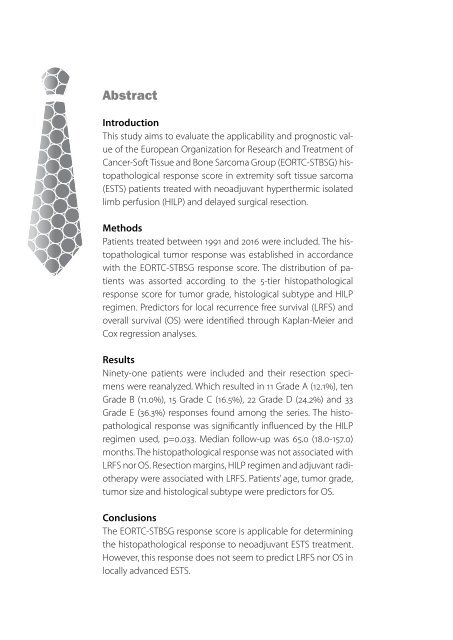Stevenson boek digi
Create successful ePaper yourself
Turn your PDF publications into a flip-book with our unique Google optimized e-Paper software.
6. Evaluation of the histopathological tumor response in pretreated sarcomas<br />
Abstract<br />
Introduction<br />
This study aims to evaluate the applicability and prognostic value<br />
of the European Organization for Research and Treatment of<br />
Cancer-Soft Tissue and Bone Sarcoma Group (EORTC-STBSG) histopathological<br />
response score in extremity soft tissue sarcoma<br />
(ESTS) patients treated with neoadjuvant hyperthermic isolated<br />
limb perfusion (HILP) and delayed surgical resection.<br />
Methods<br />
Patients treated between 1991 and 2016 were included. The histopathological<br />
tumor response was established in accordance<br />
with the EORTC-STBSG response score. The distribution of patients<br />
was assorted according to the 5-tier histopathological<br />
response score for tumor grade, histological subtype and HILP<br />
regimen. Predictors for local recurrence free survival (LRFS) and<br />
overall survival (OS) were identified through Kaplan-Meier and<br />
Cox regression analyses.<br />
Results<br />
Ninety-one patients were included and their resection specimens<br />
were reanalyzed. Which resulted in 11 Grade A (12.1%), ten<br />
Grade B (11.0%), 15 Grade C (16.5%), 22 Grade D (24.2%) and 33<br />
Grade E (36.3%) responses found among the series. The histopathological<br />
response was significantly influenced by the HILP<br />
regimen used, p=0.033. Median follow-up was 65.0 (18.0-157.0)<br />
months. The histopathological response was not associated with<br />
LRFS nor OS. Resection margins, HILP regimen and adjuvant radiotherapy<br />
were associated with LRFS. Patients’ age, tumor grade,<br />
tumor size and histological subtype were predictors for OS.<br />
Conclusions<br />
The EORTC-STBSG response score is applicable for determining<br />
the histopathological response to neoadjuvant ESTS treatment.<br />
However, this response does not seem to predict LRFS nor OS in<br />
locally advanced ESTS.<br />
Introduction<br />
Soft tissue sarcomas (STS) are relatively rare and heterogeneous tumors, including<br />
over 50 histopathological subtypes. 1 Approximately 50-60% of the STS arise in the<br />
extremities. 2 In the Netherlands, 600-700 patients are diagnosed with a STS leading to<br />
300 STS related deaths annually. 3,4<br />
Extremity soft tissue sarcomas (ESTS) patients' survival is mainly determined by metastatic<br />
potential, whereas local tumor treatment is of lesser importance. Consequently,<br />
local tumor treatment has evolved from amputation to limb salvage surgery combined<br />
with radiotherapy. 5,6 At presentation, some ESTS are considered to be locally<br />
advanced. Since the overall survival of ESTS patients is not increased by amputation of<br />
the affected limb, 5 neoadjuvant hyperthermic isolated limb perfusion (HILP), followed<br />
by surgical resection, has been used to prevent amputation in locally advanced ESTS<br />
in over 40 centers throughout Europe, 7,8 resulting in a limb salvage rate of 80-90%. 9-12<br />
Apart from neoadjuvant HILP, preoperative radiotherapy has been used in ESTS for<br />
decades. More recently, neoadjuvant chemotherapy has been tested in clinical trials<br />
in high-risk, but localized STS. 13,14 To evaluate the histopathological response to these<br />
neoadjuvant treatment strategies, a standardized approach for the pathological examination<br />
of pretreated sarcomas was proposed by the European Organization for<br />
Research and Treatment of Cancer-Soft Tissue and Bone Sarcoma Group (EORTC-STB-<br />
SG) in 2016. 15 This protocol includes a 5-tier response score based on the percentage of<br />
stainable, potentially viable tumor cells, clearly different from earlier methods in which<br />
the percentage of tumor necrosis was scored to determine the tumor response. Notably,<br />
thus far, data from the literature did not prove that the amount of tumor necrosis<br />
is prognostic in pretreated STS. 15,16 As tumor necrosis can be present in some STSs at<br />
diagnosis, it seems trustworthy to use the percentage of stainable cells in determining<br />
the histopathological response to neoadjuvant treatment. Recently, the first study<br />
applying the EORTC-STBSG response score found that it has no prognostic value with<br />
respect to recurrence free- and overall survival in a cohort of 100 extremity and trunk<br />
STS patients treated with radiotherapy prior to surgical resection. 17<br />
This single tertiary sarcoma-center study aims to assess the applicability and the prognostic<br />
value of the EORTC-STBSG response score in locally advanced ESTS patients<br />
treated with neoadjuvant HILP followed by surgical resection of the residual tumor.<br />
115



